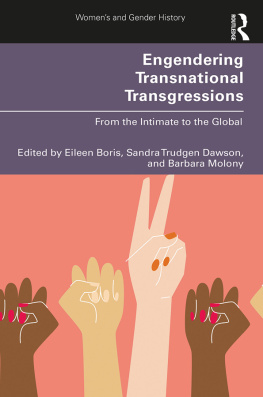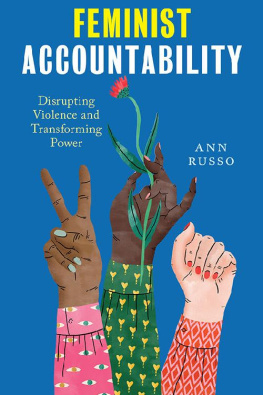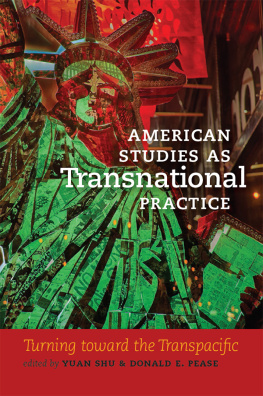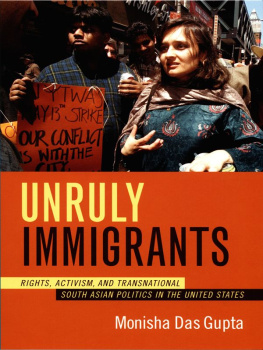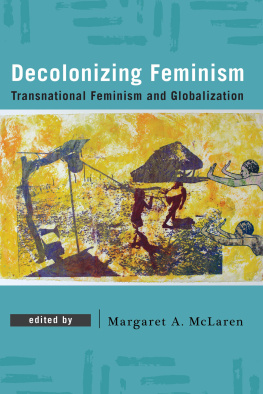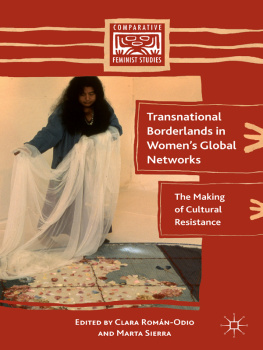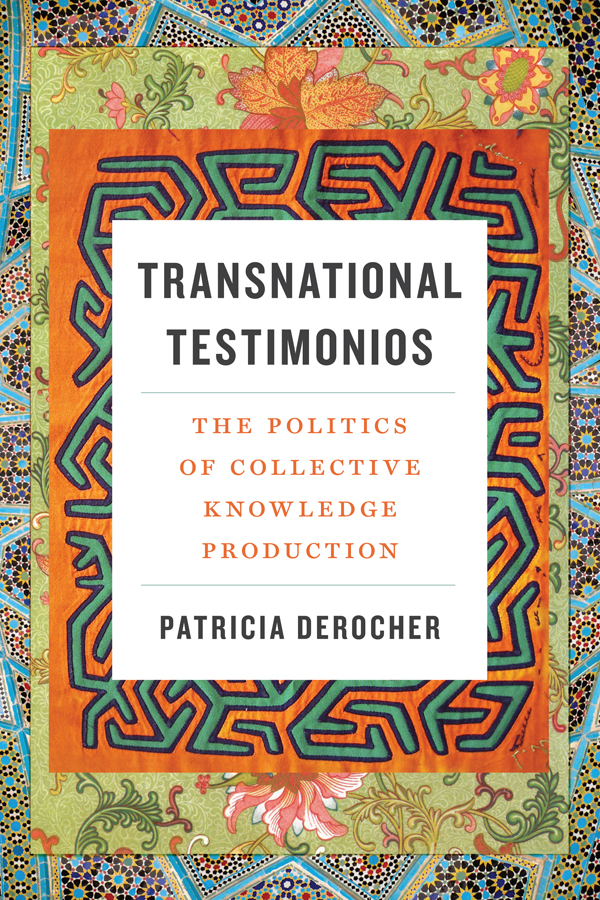Contents
Guide
Pagebreaks of the print version
DECOLONIZING FEMINISMS
Piya Chatterjee, Series Editor
Transnational Testimonios
The Politics of Collective Knowledge Production
Patricia DeRocher
UNIVERSITY OF WASHINGTON PRESS
Seattle
Copyright 2018 by the University of Washington Press
Printed and bound in the United States of America
Composed in Chaparral Pro, typeface designed by Carol Twombly
22 21 20 19 18 5 4 3 2 1
All rights reserved. No part of this publication may be reproduced or transmitted in any form or by any means, electronic or mechanical, including photocopy, recording, or any information storage or retrieval system, without permission in writing from the publisher.
UNIVERSITY OF WASHINGTON PRESS
www.washington.edu/uwpress
LIBRARY OF CONGRESS CATALOGING-IN-PUBLICATION DATA
Names: DeRocher, Patricia, author.
Title: Transnational testimonios : the politics of collective knowledge production / Patricia DeRocher.
Description: 1st Edition. | Seattle : University of Washington Press, [2018] | Series: Decolonizing feminisms | Includes bibliographical references and index. |
Identifiers: LCCN 2018004858 (print) | LCCN 2018019829 (ebook) | ISBN 9780295743929 (ebook) | ISBN 9780295743905 (hardcover : alk. paper) | ISBN 9780295743912 (pbk. : alk. paper)
Subjects: LCSH : Collective memory. | Transnationalism. | Feminism. | Indigenous peoples. | Narrative inquiry (Research method)
Classification: LCC HM1033 (ebook) | LCC HM1033 .C645 2018 (print) | DDC 909dc23
LC record available at https://lccn.loc.gov/2018004858
Portions of this book originally appeared in Testimonio and Its Travelers: Feminist Deployments of a Genre at Work, in Pushing the Boundaries of Latin American Testimony: Meta-morphoses and Migrations , edited by Louise Detwiler and Janis Breckenridge (New York: Palgrave Macmillan, 2012), and are reproduced with the permission of Palgrave Macmillan.
Cover illustrations from Wikimedia Commons: ( foreground ) traditional mola with geometric pattern, photo by Stefan Laube; ( midground ) detail of Chinese vase from Owen Jones, Examples of Chinese Ornament (S. & T. Gilbert, 1867); ( background ) glazed ceramic tile work, Tomb of Hafez, Iran, photo by Pentocelo
For Quinn
May you know more expansive futures
The truth, these stories are nothing but story, bits of string, odds and ends found here and there, embroidered together to make something new If, in the course of my inventing, I have inadvertently stumbled on the truth, perdnenme .
SANDRA CISNEROS, CARAMELO
Contents
Preface
Those who authentically commit themselves to the people must re-examine themselves constantly.
PAULO FREIRE, PEDAGOGY OF THE OPPRESSED
During my second year of college teaching, I assigned Toni Cade Bambaras The Lesson in an introduction to literature course at a predominantly white liberal arts college outside Burlington, Vermont. While on the plane back from visiting the University of Minnesota, Twin Cities, where I had just been accepted as a PhD student, I started to grade a student paper that responded to an essay question I had formulated on the significance of Bambara having her child narrator speak in black vernacular English.
We had spent significant time discussing language politics in the course, generally, and I had also provided students with a piece of literary criticism specifically discussing Bambaras language choice in the short story. So I found myself absolutely horrified when I began reading an essay that argued that Bambaras purpose was to illustrate that the little girl was not very intelligent. My stomach dropped: What had I done (or not done?) as a professor to allow this student to provide such a violent misinterpretation of Bambaras work ?
It was also during this time that, after teaching my college courses in the morning, I would head over to work as a facilitator at an after-school program at a local elementary school. Organized by a local community center that serviced a number of New American families, mostly of color, the melting pot program included the goal of helping students assimilate into US culture. Looking back, I can see how this logic permeated the ways in which many of the school counselors and teachers engaged with students. I remember the gym coach matter-of-factly commenting on how half of the students wouldnt finish high school, and one of my supervisors informing a young black student that his language was incorrect. But mostly what I saw were children passionate about life, sharing their cultures and languages with each other, taking out the globe and looking to see where their friends were from. I remember one of the older students commenting that the next time the art teacher treated him like that, he was going to pull a Rosa Parks; and I remember the time I sat silently swinging next to an emotionally distraught student from the Republic of Congo after the principal had told him that his belief in animal spiritsa part of his Luba epistemologywas wrong. The next day I would start my morning with a room full of socially privileged white college students, disproportionately groggy and uninspired, slouched in their chairs, waiting for class to end so they could go play their video games.
The juxtaposition of these social spaces was deeply troubling to mehow was it that these schools, just minutes away from each other, could be such worlds apart? What would it take for the students sitting in my college classroom to really see and hear the child narrator in The Lesson, who so reminded me of the joyful children who greeted me every afternoon? What would it take for the children in the after-school program to gain cultural access to the world of the college classroom that my college students took for granted?
Feeling defeated, I leapt down the proverbial rabbit hole. What, exactly, does literature do, anyway? I wondered. How does it act on the world? When I first entered a doctoral program with a strong social science focus, literature seem peripheral. And yet, as I took courses in history and public policy, I noticed how the role of narrative remained front and center in everything we discussed. Narration was everywhere, all around me, all the time. When I stumbled upon my first testimonios, they seemed to provide the structural answer I was looking for. Testimonioscreatively shaped stories that refer outwardly to actual life eventswere narratives that intentionally resided at the nexus of the discursive and the material. At the time, I interpreted testimonio as an acknowledgment of the limits of art in social justice projects, and as privileging the documentary, rather than how I now see it: as a definitive assertion of cultural work being integral to social justice platforms.
These conundrums and experiences are what planted the seeds for what has become this book, and what have informed the questions I have sought answers to in the ten years since. While this book focuses on polyvocal feminist testimonios, it is the political, theoretical, and philosophical questions they raise that led me to them in the first place, and that allow me a tangible focal point in which to ground the epistemic questions that I continue to grapple with in my academic and personal lives. It is their insistence of engaging with the politics of representation, and their recognition of the centrality of the cultural imaginary to consolidate or disrupt social inequalities, that I find so compelling.
At a fundamental level, I understand polyvocal feminist testimonio as a form of transnational feminist praxis that strategically performs epistemic translations by providing a textual bridge between practitioners and readers of vastly different social worlds. In contrast to traditional testimonio, primarily aimed at reaching a northern audience, I understand these works to be a form of connected activism (Medina 228) that are epistemically useful to the practitioners themselves while also seeking out horizontal South/South relationships and northern readerships. Practitioners commitment to reaching multiple audiences necessarily deepens the epistemic reach of testimonios, a reach furthered by multivoiced narrative frameworks that create productive epistemic friction (23), a form of dialogic interaction between differently socially situated subjects that helps to expand the epistemic worlds inhabited by both practitioners and readers. This polyvocal narrative strategy models in textual form the possibility of what Medina terms a kaleidoscopic consciousness (200), or an opening up of our epistemic worlds that allows us to read the same event through different social lenses. As I argue in the pages that follow, the cultural work that these texts accomplish are at once theoretically and methodologically complex and grounded and pragmatic, interrupting dominant flows of knowledge production. They also necessitate my own working across borders, most notably in relation to the multiple audiences for this book.



